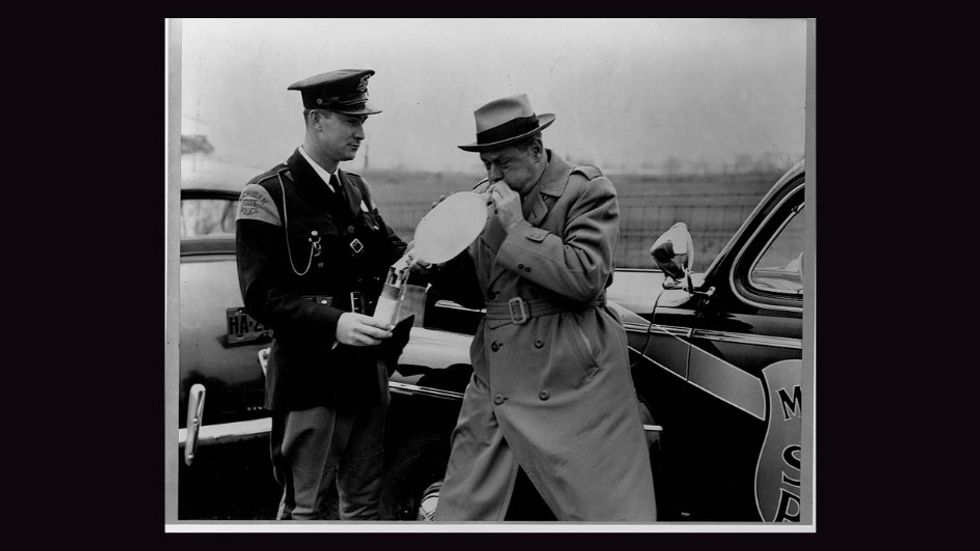
www.theblaze.com
Dystopian future as misguided safety push sends drivers to 'kill switch jail'
Imagine your 2026 car shutting off mid-drive because it thinks you’re drunk or otherwise impaired. That’s real! And you can find it in Section 24220 of the 2021 Infrastructure Investment and Jobs Act — a mandate still alive despite fierce pushback, set to raise car prices and spark debate.Proponents of the so-called "kill switch" say they just want to make the roads safer. But at what cost?Consider the possibility of misreadings and technical errors. It's bad enough when a glitch keeps us out of an app or prevents us from sending an email. Now, imagine having the autonomy and freedom that comes with your car being taken from you at will.No restart Keep in mind that there are no reset or restart protocols outlined in the law. The National Highway Traffic Safety Administration hasn’t finalized these rules yet, so any description of how a car restarts remains speculative based on current tech trends and the law’s intent.No wonder they call it "kill switch jail." And unlike regular jail, you don't get to plead your case. This is not just a gadget; it’s a computer judging us behind the wheel. When the bill passed, X erupted — drivers posted memes of cars as “nanny cops,” while safety groups cheered it as a lifeline. This all depends on passive alcohol monitoring — a new and relatively untested technology in which no breathalyzers are required. You simply breathe normally and sensors in the cabin will tell you if you're good to go. It's like having a traffic cop in the passenger seat, administering a continuous DUI check. In other words, you're guilty until proven innocent. Freedom vs. safetyA 2022 survey by the American Automobile Association found 62% of Americans worry about tech overreach in cars, yet 55% support drunk-driving fixes. This clash — freedom versus safety — is why Section 24220’s so divisive. As of March 31, 2025, it’s barreling toward reality. Can it be stopped? Will it save lives or just pad profits for insurance companies? Or is it going to stop drivers from buying a 2026 model car? We don’t need more nannies in our cars. Here’s the latest and what it means for your next ride.Section 24220, tucked into the 1,100-page Infrastructure Investment and Jobs Act — signed by President Biden on November 15, 2021 — requires every new car sold after 2026 to include “advanced impaired driving technology.” This means cameras, sensors, or breath detectors passively monitoring your driving to detect if you’re drunk, distracted, or drowsy. If flagged, the car could stall or refuse to start. The law cites 10,142 alcohol-impaired driving deaths in 2019, aiming to tackle a $44 billion problem from 2010 data — adjusted to roughly $60 billion today with inflation, per the Bureau of Labor Statistics. The pitch was: Save lives and cut costs. Murky detailsThe details are murky at best. The tech could include the Driver Alcohol Detection System for Safety funded by the NHTSA, based on three possible technologies targeting an .08 blood alcohol concentration cutoff: a touch sensor on the steering wheel sniffing alcohol through your skin; a touch sensor on the push-button ignition; or the aforementioned breath scanner in the cabin.This information would be enhanced with other "evidence" gleaned from your car eavesdropping on your speech, monitoring your eyes through infrared sensors and cameras hidden in the dash or rearview mirror to detect a possible issue. Who decides if you need to pull over? A computer decides. Again, welcome to “kill switch jail."Disputed accuracyTests in 2023 claimed these systems could operate at 85% accuracy, but a Virginia Tech study found that something as simple as cold weather or the driver wearing gloves could disrupt it. Cameras, like those in Tesla’s driver-monitoring system, watch your eyes — slow blinks or glances away trigger alerts. Volvo’s 2024 XC90 flags fatigue, but the Insurance Institute for Highway Safety reports a 10% false-positive rate in dim light. These aren’t sci-fi toys; they’re real, flawed, and racing toward your dashboard. As of 2024, NHTSA has not defined the rules, with a possible three-year delay if the tech isn’t ready. How about defunding and removing this rule?!Massie leads the chargeRep. Thomas Massie of Kentucky (R) has led the charge against the mandate, calling it a “privacy nightmare” and “federal overreach.” In November 2023, his amendment to defund Section 24220 won 199 Republicans and two Democrats but failed with 229 to 201 votes, when 19 Republicans — including Rep. Nancy Mace (S.C.), Rep. Mike Garcia (Calif.), and Rep. Don Bacon (Neb.) — joined 210 Democrats to keep it alive. Mace, a safety hawk after pushing a 2022 DUI crackdown in South Carolina, sees it as a legacy win, while Garcia’s district hosts tech firms like Qualcomm, hinting at job promises. The Alliance for Automotive Innovation — representing General Motors, Toyota, and Ford — lobbied $12 million in 2021 to shape the bill, per OpenSecrets.Democrats lean on NHTSA’s 2022 “Vision Zero” pledge for zero traffic deaths by 2050, but critics like Sen. Rand Paul (R-Ky.), in a 2023 speech, warned of a “surveillance state on wheels.” In February 2025, Massie grilled Michael Hanson of the Governors Highway Safety Association in a House hearing, demanding proof of this working tech. Hanson admitted it’s untested at scale, unlike seatbelts, which were standard in cars by the 1960s before mandates, or ignition interlock devices, which are breathalyzers that lock the car if you’re over the limit and cut repeat DUIs by 70%, per Mothers Against Drunk Driving. Massie’s still fighting, but time’s running out: 2026 models are being built starting this summer.Duffy to the rescue?As of March 31, 2025, NHTSA’s rules remain unpublished. This is now in the hands of Secretary Sean Duffy. It can push it to 2027 with a progress report to Congress if tech lags, and with 2026 just months away, automakers are scrambling. A 2022 repeal attempt — the Safeguarding Privacy in Your Car Act (S.4647) from Republican Sens. Mike Rounds (S.D.), Mike Braun (Ind.), and John Cornyn (Texas) — sits stalled in committee. NHTSA’s January 2024 proposal floats camera options, eyeing production in 2025 — maybe. Without a repeal, this kill switch still looms over consumers.An expensive propositionThe cost will hit drivers hard, as adding cameras, sensors, and artificial intelligence to vehicles could tack hundreds of dollars onto each of the millions of new cars sold yearly in the U.S. This equals a $3.4 to $8.5 billion annual jump, straight from buyers’ pockets. By 2030, 80% of cars will be connected. Expect more shop visits for failed sensors and software glitches — which will, in turn, increase the cost of insurance and ownership.The NHTSA says this driver-monitoring tech could save 9,400 lives a year and erase a $60 billion burden from drunk driving: from lost jobs, hospital bills, and wrecked cars. In 2021, insurance companies paid out big for alcohol-related crashes, according to the Insurance Information Institute, but your premiums didn’t change — they just kept the extra cash. Hospitals didn’t lower bills, either. That $60 billion saving goes to them, not you. Will it work?So will it work? Drunk driving took over 12,000 lives in 2021, mostly from drivers over the legal limit, contributing to over 42,000 total traffic deaths — a 16-year high. Tougher laws and ignition interlock devices, such as breathalyzers that lock the car, have cut deaths by nearly a third since 1990, with millions installed, per Mothers Against Drunk Driving. Still, 2021’s jump sparked this push.What about these high-tech in-car cameras? A 2024 study by the Swedish Transport Agency found Volvo’s Driver Alert Control system dropped fatigue crashes 20%, yet 15% of alerts were false. While this is a good example, glitches and privacy fears could tank drivers' trust in these new technologies. Data on your speed or habits could leak to insurers (jacking up premiums), advertisers (targeting you with ads), or the police. NHTSA denies a police kill switch, but hacking or future laws could shift that. Supporters argue NHTSA's estimated 9,400 lives saved justify it — if it’s flawless, which it definitely isn’t yet.The 2026 deadline — set to sync with new models — gave automakers five years to get it done. By 2026, or 2029 if pushed, every new car could carry this new technology, raising prices and watching you like Big Brother. Massie has been applying pressure, but without a Senate breakthrough, expect that couple-hundred-dollar hike, no insurance relief, and a car that might misjudge you, sticking you in "kill switch jail."So is this safety or overreach? What’s your take?














